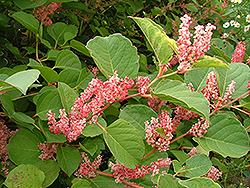It's all about ...
plants

Glo-worm Japanese Knotweed
Polygonum reynoutria 'Glozam'
Height: 24 inches
Spacing: 20 inches
Sunlight:
![]()
![]()
Hardiness Zone: 3a
Other Names: Fleeceflower
Description:
This variety is a vigorous, clump forming plant with strongly veined, large oval leaves; produces dense spikes of small flowers in shades of pink, that are impressive when massed in the garden or along borders
Ornamental Features
Glo-worm Japanese Knotweed has masses of beautiful spikes of rose flowers with white overtones rising above the foliage from early to late summer, which are most effective when planted in groupings. The flowers are excellent for cutting. Its large oval leaves remain forest green in colour with curious grayish green undersides throughout the season.
Landscape Attributes
Glo-worm Japanese Knotweed is an herbaceous perennial with a mounded form. Its medium texture blends into the garden, but can always be balanced by a couple of finer or coarser plants for an effective composition.
This plant will require occasional maintenance and upkeep, and is best cleaned up in early spring before it resumes active growth for the season. Gardeners should be aware of the following characteristic(s) that may warrant special consideration;
- Spreading
Glo-worm Japanese Knotweed is recommended for the following landscape applications;
- Mass Planting
- General Garden Use
- Groundcover
- Bog Gardens
Planting & Growing
Glo-worm Japanese Knotweed will grow to be about 20 inches tall at maturity, with a spread of 24 inches. When grown in masses or used as a bedding plant, individual plants should be spaced approximately 20 inches apart. Its foliage tends to remain dense right to the ground, not requiring facer plants in front. It grows at a fast rate, and under ideal conditions can be expected to live for approximately 10 years. As an herbaceous perennial, this plant will usually die back to the crown each winter, and will regrow from the base each spring. Be careful not to disturb the crown in late winter when it may not be readily seen!
This plant does best in full sun to partial shade. It is quite adaptable, prefering to grow in average to wet conditions, and will even tolerate some standing water. It is not particular as to soil type or pH. It is highly tolerant of urban pollution and will even thrive in inner city environments. This is a selected variety of a species not originally from North America. It can be propagated by division; however, as a cultivated variety, be aware that it may be subject to certain restrictions or prohibitions on propagation.
